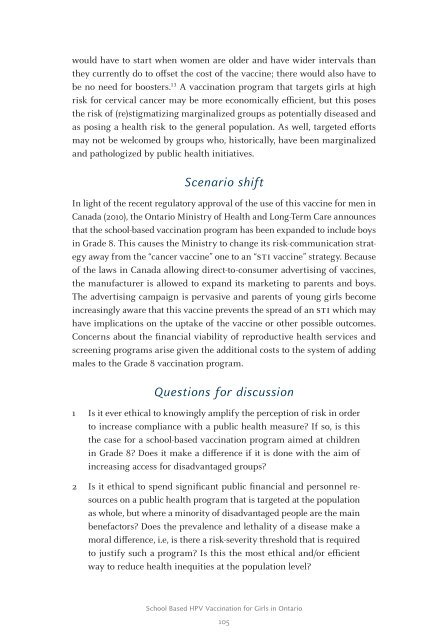PoPulationand Public HealtH etHics
PoPulationand Public HealtH etHics
PoPulationand Public HealtH etHics
Create successful ePaper yourself
Turn your PDF publications into a flip-book with our unique Google optimized e-Paper software.
would have to start when women are older and have wider intervals than<br />
they currently do to offset the cost of the vaccine; there would also have to<br />
be no need for boosters. 13 A vaccination program that targets girls at high<br />
risk for cervical cancer may be more economically efficient, but this poses<br />
the risk of (re)stigmatizing marginalized groups as potentially diseased and<br />
as posing a health risk to the general population. As well, targeted efforts<br />
may not be welcomed by groups who, historically, have been marginalized<br />
and pathologized by public health initiatives.<br />
Scenario shift<br />
In light of the recent regulatory approval of the use of this vaccine for men in<br />
Canada (2010), the Ontario Ministry of Health and Long-Term Care announces<br />
that the school-based vaccination program has been expanded to include boys<br />
in Grade 8. This causes the Ministry to change its risk-communication strategy<br />
away from the “cancer vaccine” one to an “stI vaccine” strategy. Because<br />
of the laws in Canada allowing direct-to-consumer advertising of vaccines,<br />
the manufacturer is allowed to expand its marketing to parents and boys.<br />
The advertising campaign is pervasive and parents of young girls become<br />
increasingly aware that this vaccine prevents the spread of an stI which may<br />
have implications on the uptake of the vaccine or other possible outcomes.<br />
Concerns about the financial viability of reproductive health services and<br />
screening programs arise given the additional costs to the system of adding<br />
males to the Grade 8 vaccination program.<br />
Questions for discussion<br />
1 Is it ever ethical to knowingly amplify the perception of risk in order<br />
to increase compliance with a public health measure? If so, is this<br />
the case for a school-based vaccination program aimed at children<br />
in Grade 8? Does it make a difference if it is done with the aim of<br />
increasing access for disadvantaged groups?<br />
2 Is it ethical to spend significant public financial and personnel resources<br />
on a public health program that is targeted at the population<br />
as whole, but where a minority of disadvantaged people are the main<br />
benefactors? Does the prevalence and lethality of a disease make a<br />
moral difference, i.e, is there a risk-severity threshold that is required<br />
to justify such a program? Is this the most ethical and/or efficient<br />
way to reduce health inequities at the population level?<br />
School Based HPV Vaccination for Girls in Ontario<br />
105
















